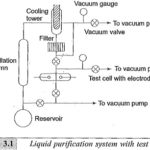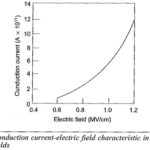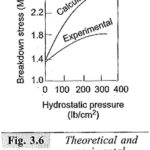Conduction and Breakdown in Liquid Dielectrics Articles:
Liquid Dielectrics Breakdown: Liquid dielectrics, because of their inherent properties, appear as though they would be more useful as insulating materials than either solids or gases. This is because both liquids and solids are usually 103 times denser than gases and … (Read More)
Classification of Liquid Dielectrics: In recent years, a substitute to mineral oils, other polyester oils have been developed which are extensively used in transformers in Europe and other countries. One such oil is the halogen free Penta-Etythrite-Tetra Fatty Acid. Polyester oil (PETFP oil) … (Read More)
Characteristics of Liquid Dielectrics: Essential Characteristics of Liquid Dielectrics should possess good dielectric properties, excellent heat transfer characteristics and must be chemically stable under the range of conditions under which the equipment operates. These are briefly discussed below. (a) Electrical Properties The electrical properties … (Read More)
 Pure Liquids and Commercial Liquids: Pure liquids are those which are chemically pure and do not contain any other impurity even in traces of 1 in I09, and are structurally simple. Examples of such simple pure liquids are n-hexane (C6H14), n-heptane … (Read More)
Pure Liquids and Commercial Liquids: Pure liquids are those which are chemically pure and do not contain any other impurity even in traces of 1 in I09, and are structurally simple. Examples of such simple pure liquids are n-hexane (C6H14), n-heptane … (Read More)
 Conduction and Breakdown in Pure Liquids: When low electric fields less than 1 kV/cm are applied, conductivities of 10-18-10-20 mho/cm are obtained. Conduction and Breakdown in Pure Liquids are probably due to the impurities remaining after purification. However, when the fields … (Read More)
Conduction and Breakdown in Pure Liquids: When low electric fields less than 1 kV/cm are applied, conductivities of 10-18-10-20 mho/cm are obtained. Conduction and Breakdown in Pure Liquids are probably due to the impurities remaining after purification. However, when the fields … (Read More)
 Conduction and Breakdown in Commercial Liquids: As already mentioned, Conduction and Breakdown in Commercial Liquids are not chemically pure and have impurities like gas bubbles, suspended particles, etc. These impurities reduce the breakdown strength of these liquids considerably. The breakdown mechanisms … (Read More)
Conduction and Breakdown in Commercial Liquids: As already mentioned, Conduction and Breakdown in Commercial Liquids are not chemically pure and have impurities like gas bubbles, suspended particles, etc. These impurities reduce the breakdown strength of these liquids considerably. The breakdown mechanisms … (Read More)